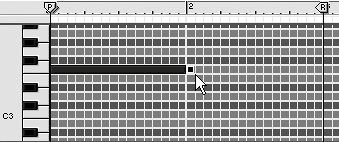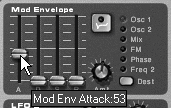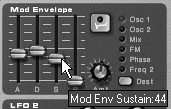| Don't throw that sustained-note loop away just yet…we're going to use it to learn about the modulation envelope. The mod envelope works just like the amp and filter envelopes, but it accepts parameters from you to tell it what to raise and lower (Figure 5.52). Figure 5.52. The modulation envelope controls 
The mod envelope also depends on the amp envelope for signals, just as the filter envelope does. If the amp envelope release is off, there won't be an audible release stage for the modulation envelope, either. To pitch-modulate Osc 1 with the mod envelope's attack 1. | Save any settings you may want to keep, and load the test patch.
| 2. | Set all the mod envelope faders to 0, and set the amp envelope release fader to 82 (Figure 5.53). This gives your mod envelope the stages it needs for this demonstration.
Figure 5.53. Set the amp envelope to enable all note stages so that the mod envelope can affect them. 
| 3. | Keep your loop length at two measures, but shorten the sustained note to one bar (Figure 5.54).
Figure 5.54. Set up a sustained note with some space after it so you can test the release stage. 
| 4. | Set the mod envelope Dest to Osc 1.
| 5. | Turn the mod envelope Amt knob to the right to about 71, and play your sustained loop.
| 6. | To cause the Osc 1 pitch to ramp up at the attack stage, move the mod envelope A fader to 53 (Figure 5.55).
Figure 5.55. Set the mod envelope attack fader above 0 to hear a pitch ramp at the beginning of a note. 
The sound will now bend upward in pitch at the beginning of the note and then drop down abruptly (there is no decay stage yet).
|
To adjust the mod envelope D, S, and R values 1. | With your sustained loop playing and your A fader still at 53, move the mod envelope D fader to 59 (Figure 5.56). Now the pitch will ramp down during the decay stage.
Figure 5.56. The decay stage sets the time it will take to ramp down the pitch to the level of the sustain fader. 
| 2. | Move the S fader to 44 (Figure 5.57).
Figure 5.57. When modulating pitch, the mod envelope's sustain stage sets a frequency. At 44, the pitch of the sustained note will settle on a high note. 
After the decay stage, you will hear the pitch settle to a steady tone during the sustain stage. The note will abruptly drop down to the starting pitch (there is no release stage yet).
| 3. | Now move the R fader to 82.
Through the second bar of your loop, you'll hear a slow ramp back down to the starting pitch as the amp envelope's release stage fades.
|
 Tip Tip
Short-duration mod envelope effects sometimes behave strangely. For example, when running your bass line with the mod envelope set to Osc 1, your decay fader alone can seem to be doing three different things. To use the mod envelope's decay stage on short notes 1. | Set up your Sequencer to play your bass line.
| 2. | Reset all the mod envelope faders to 0 and the Dest to Osc 1.
| 3. | Set your Polyphony count to 1 so that your notes don't overlap.
| 4. | Play your loop, and turn up the mod envelope Amt knob.
You should be hearing the first decay effect: a percussive pulse or noise transient. The pulse is the decay dropping the pitch at maximum rate (0 in this case) and creating an impact sound.
| 5. | Lengthen the decay to 53 and it becomes a laser swooping sound.
| 6. | Continue moving the D fader up. Past halfway, the decay will exceed your note length, cutting off the swoop sound. The result will be a second tone that seems to toggle off the firstlike a ringing cell phone.
The ring tone gets higher when you raise the decay fader more. This is a phantom effect, since the pitch modulation isn't really changing pitch; what's changing is just the point where the decay pitch swoop is cutting off. As the decay slope decreases, the cutoff point rises.
|
 Tip Tip
|






 Tip
Tip